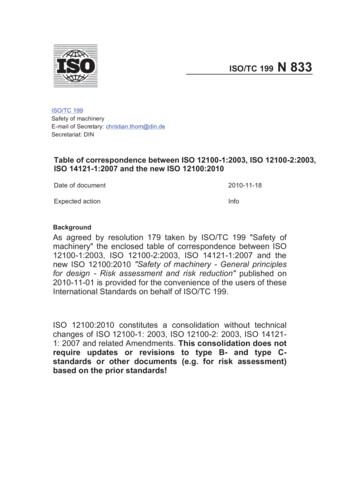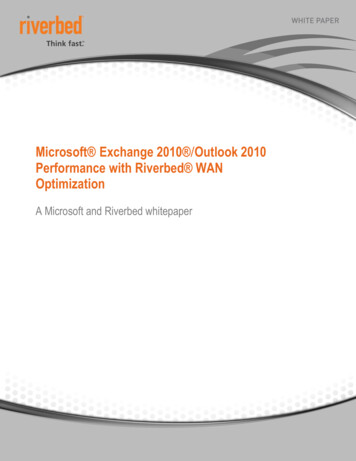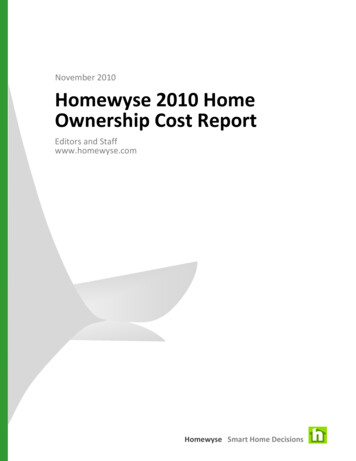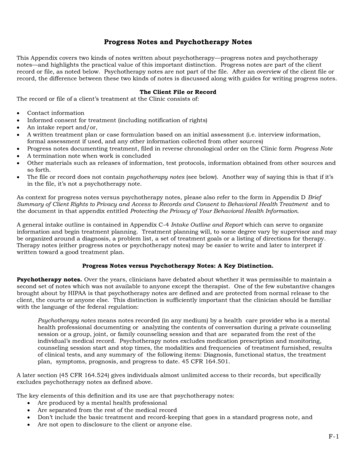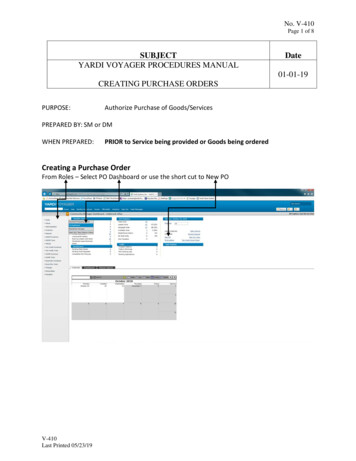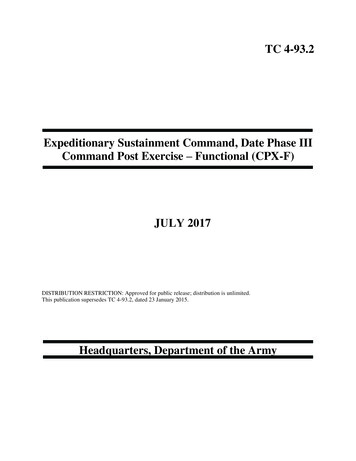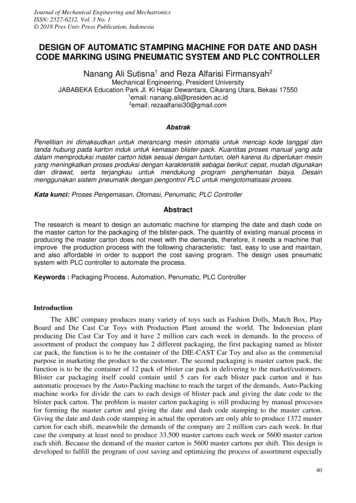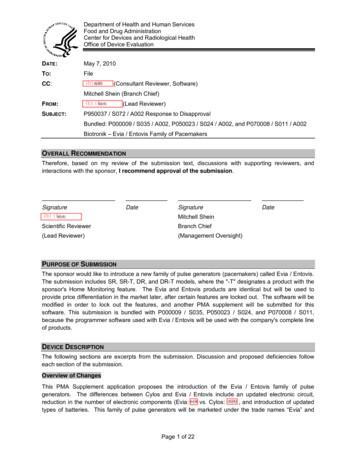
Transcription
Department of Health and Human ServicesFood and Drug AdministrationCenter for Devices and Radiological HealthOffice of Device EvaluationNotesDATE:May 7, 2010TO:File(b)(6)(b)(6)CC:(Consultant Reviewer, Software)Mitchell Shein (Branch Chief)(Lead Reviewer)FROM:(b)(6)(b)(6)SUBJECT:P950037 / S072 / A002 Response to DisapprovalBundled: P000009 / S035 / A002, P050023 / S024 / A002, and P070008 / S011 / A002Biotronik – Evia / Entovis Family of PacemakersOVERALL RECOMMENDATIONTherefore, based on my review of the submission text, discussions with supporting reviewers, andinteractions with the sponsor, I recommend approval of the ell SheinScientific ReviewerBranch Chief(Lead Reviewer)(Management Oversight)DatePURPOSE OF SUBMISSIONThe sponsor would like to introduce a new family of pulse generators (pacemakers) called Evia / Entovis.The submission includes SR, SR-T, DR, and DR-T models, where the "-T" designates a product with thesponsor's Home Monitoring feature. The Evia and Entovis products are identical but will be used toprovide price differentiation in the market later, after certain features are locked out. The software will bemodified in order to lock out the features, and another PMA supplement will be submitted for thissoftware. This submission is bundled with P000009 / S035, P050023 / S024, and P070008 / S011,because the programmer software used with Evia / Entovis will be used with the company's complete lineof products.DEVICE DESCRIPTIONThe following sections are excerpts from the submission. Discussion and proposed deficiencies followeach section of the submission.Overview of ChangesThis PMA Supplement application proposes the introduction of the Evia / Entovis family of pulsegenerators. The differences between Cylos and Evia / Entovis include an updated electronic circuit,(b)(4)(b)(4)reduction in the number of electronic components (Evia: (b)(4)vs. Cylos: (b)(4), and introduction of updatedtypes of batteries. This family of pulse generators will be marketed under the trade names “Evia” andPage 1 of 22
“Entovis” even though the devices are identical. The Evia / Entovis pulse generators were initiallydeveloped with the engineering project name “Primus.” Therefore, all references to “Primus” providedwithin this PMA Supplement are synonymous with the “Evia / Entovis” family of pulse generators.The Evia / Entovis family of pulse generators contains the same feature set as the Cylos family of pulsegenerators with the addition of the following feature updates: Automatic Sensitivity control (ASC) Atrial Capture Control Vp Suppression (Ventricular pace suppression) Modified Auto Initialization (Auto Lead Polarity and Function Activation) More automated follow-upAdditionally, the following features are introduced with the new US software version, 901.U: "Indication-dependent program recommendation (ProgramConsult )" and "Store individualprograms" "Automatic threshold measurement in the atrium" (measured by the ICS 3000 programmer) Easy AV display of the As-Vs Statistics in the AV delay screenFigure 1 shows the relationship between the Evia / Entovis families of Implantable Pulse Generators andBIOTRONIK’s currently approved pulse generators, Cylos, Philos II and Protos.ProtosPhilos IIwith CLS method of rateadaptive pacing(P950037/S36, approved(P950037/S32, approvedCylosMinor modifications to approved featuresand additional features as described hereinPage 2 of 22
Evia and EntovisFigure 1: History of BIOTRONIK Pulse GeneratorsBIOTRONIK obtained FDA approval of the Philos II family of rate-adaptive cardiac pulse generators onMarch 31, 2004 under PMA Supplement P950037/S36. The Protos family of pulse generators wasoriginally approved through P950037/S28 on December 6, 2002. The Cylos family of rate-adaptivecardiac pulse generators was originally approved through P950037/S41 on December 21, 2005.The Evia / Entovis families of Implantable Pulse Generators are available in four different variants: DR,DR-T, SR and SR-T with the T variants having BIOTRONIK’s Home Monitoring functionality. The Evia /Entovis DR, Evia / Entovis DR-T, Evia / Entovis SR, and Evia / Entovis SR-T are detailed in the drawingsthat are included in Appendix 1, Appendix 2, Appendix 3, and Appendix 4, respectively. The Evia /Entovis family of pulse generators are identical; however, they will be marketed under different tradenames. Consequently, Evia will be used throughout this submission to describe both the Evia andEntovis devices.(b)(4)Evia utilizes the (b)(4)substrate for the printed circuit boards, which is also currently approved inBIOTRONIK’s Philos (P950037/S51, dated August 31, 2007) and Philos II (P950037/S65, datedNovember 6, 2008) pulse generators. All patient contact materials used to manufacture the Evia pulsegenerators are identical to those utilized in the currently approved Cylos family in formulation, processing,and sterilization, and no other chemicals have been added (e.g., plasticizers, fillers, and color additives,cleaning agents, mold release agents, etc.). There are no changes in any tissue/blood contact materialsfor the Evia pulse generators compared to the currently marketed Cylos pulse generators. Furthermore,the shelf life of 18 months for Evia is identical to that for the Cylos family of pulse generators.The current legally marketed programmer software version, 802.U/2 (P950037/S67, datedMarch 31, 2009), has been modified to include the application for programming the Evia family of pulsegenerators. The updated ICS 3000 programmer software will be identified as 901.U.Similar to the Cylos family of pulse generators, the Evia family of implantable pulse generators utilizesIS-1 lead connectors and there are no new requirements in terms of lead compatibility. Evia uses thebi-directional Home Monitoring patient device, CardioMessenger II-S (TLine) approved underP050023/S16, dated December 11, 2008.The Evia family of implantable pulse generators includes the Closed Loop Stimulation (CLS) method ofrate adaptive pacing utilizes patient-specific impedance measurements to determine the pacing rate.CLS was approved by the FDA for Cylos pulse generators under P950037/S41, datedDecember 21, 2005. CLS is implemented in the Evia family of pulse generators in an identical manner ascompared to the Cylos family.Page 3 of 22
DiscussionThe proposed changes and descriptive comparison to previous devices and supporting data werereviewed. There were some questions regarding the changes, which the sponsor was able to resolvewith information provided in amendments to the submission.Detailed Device DescriptionThe Evia family of pulse generators contains the same feature set as the legally marketed Cylos family ofpulse generators (P950037/S41, dated December 21, 2005).In addition to these core functions, the Evia pulse generators will have the following: Automatic operation for:o Sensing (Auto Sensing for atrial and ventricular channel)o Atrial Capture Control (and – already existing - Ventricular Capture Control)o Follow Up (programmer based automatic features to ease Follow-ups)o Ventricular Pace Suppression (Vp Suppression) Bi-directional Home Monitoring with periodic IEGM transmission Additional functionality with the ICS 3000o New graphical user interface (GUI) with ICS 3000o Data transfer to data manager capabilitieso EasyAV (assistance with setting of AV delay)o ProgramConsult (assistance with device programming)o TrendView (expanded diagnostics)The features from Cylos that are not implemented in the Evia family are: 2:1 Lock-In Protection NIPS (Non-Invasive Programmed Stimulation)The Home Monitoring models of the Evia / Entovis families of Implantable Pulse Generators (Evia /Entovis DR-T and Evia / Entovis SR-T) can be utilized with BIOTRONIK’s currently approved HomeMonitoring Service Center (P950037/S66, dated November 21, 2008; and P950037/S69, datedMarch 23, 2009). The method of data transmission from the Evia / Entovis DR-T/SR-T to the patientdevice remains unchanged as compared to the Cylos DR-T.The main hardware components are based on the hardware used for the Cylos family of pulse(b)(4)generators. As the predecessors, the Evia devices contain embedded software (firmware) and the (b)(4)(b)(4)(b)(4)firmware version is.Evia pulse generators are capable of storing up to 20 IEGM snapshots, which is identical to the Cylosfamily of pulse generators. Additionally, the sensor for accelerometer-based activity is identical to thatused in the Cylos family.The housing and header used for the Evia family of pulse generators are identical in materials andmanufacturing processes to what is used in the Cylos pulse generators, and are made of titanium andepoxy resin, respectively. Table 1 shows a size comparison of the Evia and Cylos pulse generators.Table 1: Evia and Cylos Size ComparisonModelEvia DRCylos DREvia DR-TCylos DR-TVolume11 cc12 cc12 cc14 ccPage 4 of 22
Mass26 g28 g25 g31 gDimensions6.5 x 43 x 53 mm6.4 x 42 x 57 mm6.5 x 45 x 53 mm6.4 x 50 x 57 mmThe Evia longevity is as specified in the technical manual, which is provided in Appendix 124.technical comparison summary of the Evia and Cylos pulse generators is shown in Table 2.ATable 2: Technical ComparisonProduct variantsEvia / EntovisCylosDR, DR-T, SR, SR-TDR, DR-T, VRTitanium housing withphysiologic shapeidenticalEpoxy - HeaderidenticalConnector portsDR(-T): 2*IS-1SR(-T): 1*IS-1Circuit(b)(4)Hybrid electronics with (b)(4)TechnologySubstrate(b)(4)(b)(4)Pulse form1chip(b)(4)(b)(4)-SubstrateBiphasic, asymmetricCurrent limiting(b)(4)Cut-off voltageOutput capacitor(b)(4) Input impedanceDC protection2GB 8431LiS 3150BatteriesGB 2596LiS 3150Mas described belowGB 8431LiS 3150Additional Battery ModelsThe Evia family utilizes four types of batteries which are manufactured by Greatbatch and Litronik. TheGB 2596 and LiS 3150M batteries are new battery models that will be implemented in Evia DR-T andEvia SR-T devices. These batteries will offer higher current and voltage to support Home MonitoringIEGM transmissions. Table 3 shows the characteristics of each type of battery.Table 3: Evia / Entovis Battery CharacteristicsManufacturerGREATBATCH, INC.Clarence, NY14031, USABattery TypeGB8431GB2596LiS 3150LiS 3150MLiJAg/SVO/CFxQMR LiJLiMn02System12LITRONIK GmbH01796Pirna, GermanyFR4 has been approved in Philos (P950037/S51, dated 8-31-2007) and Philos II (P950037/S65, dated 11-6-2008)Calculated values provided by manufacturerPage 5 of 22
ModelDR, SRDR-T, SR-TDR, SRDR-T, SR-TBattery voltage at BOS2.8 V3.0 V2.8 V3.1 VOpen-circuit voltage2.8 V3.0 V2.8 V3.1 VNominal capacity1.3 Ah1.3 Ah1.3 Ah1.2 AhUseable capacity until EOS(at Standard Program:3V/0.4ms, 60ppm; 500Ω)1.2 Ah1.1 Ah1.2 Ah1.0 AhAs a result of the different battery types, the programmer screen will display the battery information in anew way. Voltage, current, and battery impedance will not be displayed on the screen in order to avoidconfusion due to the different battery dependent values. The only energy indicator on the programmer isthe fuel gauge on the follow-up screen together with the calculated time to ERI as shown in Figure 2.The fuel gauge is independent of the current programmed parameters; it is directly related to theremaining usable battery capacity.Figure 2: Battery Indicators on the Programmer ScreenDiscussionThe proposed changes to the battery and longevity related features and supporting data were reviewed.There were some questions regarding these changes, which the sponsor was able to resolve withinformation provided in amendments to the submission.Automatic Sensitivity Control (ASC)During an atrial or ventricular tachycardia, the sensing thresholds can decrease to significantly lowervalues that are prone to undersensing in case of fixed sensing settings. Autosensing helps to correctlydetect AF episodes when the signal amplitude is significantly decreased.Consequently, theimplementation of autosensing functionality in pacemakers is common in the CRM industry. Theautosensing functionality used in Evia is functionally equivalent to the same feature utilized in theBIOTRONIK Lumax 500 / 540 ICDs (P050023/S11, dated November 4, 2008) and several previousBIOTRONIK ICDs.The electrograms measured at the tip of the leads are converted to digital signals in the analog-to-digital(b)(4)converter. The digital signals are then filtered with (b)(4)band pass. After filtering, the signals aretested against the actual sensing threshold. If two consecutive samples of the electrogram have higheramplitude than the threshold, then a sense count is generated. The following figure illustrates thesensing circuit.The above described functionality is the same for fixed threshold sensing and automatic sensitivity (ASC).In case of the fixed sensitivity, the physician programs the sensing threshold. In case of the ASCalgorithm, the device measures automatically the peak amplitude of a sensed event and adapts thesensing threshold accordingly as illustrated in Figure 3.Page 6 of 22
Figure 3: Automatic Sensitivity Control (ASC)After each sense detection (electrogram is above actual threshold for 2 consecutive samples), the ASCbegins the detection hold-off period of 121 ms in the ventricle (101 ms in the atrium) and detects withinthe first 80 ms of this interval the highest amplitude of the peak. After this initial period, the sensingthreshold is first set to 50% of the measured peak amplitude. After the step duration of 125 ms, thethreshold is set to 25% of the peak amplitude (82 ms in the atrium) but never below the minimumthreshold of 2.0 mV in the ventricle (atrium: 0.2 mV bipolar and 0.5V unipolar). This functionalityunburdens the physicians from manual programming of the sensing threshold, the ASC detects signalswith varying and small amplitudes, and the threshold is set to a 1:4 signal-to-noise ratio to eliminateunwanted detection of noise.After paced events, the sensing threshold is initially set to 2.5 mV (1 mV in the atrium), which correspondsto the default sensitivity values using fixed sensitivity settings. The detection hold-off period after a pace(see Figure 3) is doubled to 200 ms in the ventricle to avoid in-channel detection of the pacing artifact.After a paced event, the first step is with 250 ms (164 ms in the atrium) twice as long as after a sensedevent to avoid T-wave over-sensing. Environmental noise is declared if sense events occur within thenoise interval of 50 ms.DiscussionThe proposed changes to the sensing behavior and supporting data were reviewed. There were somequestions regarding the changes, which the sponsor was able to resolve with information provided inamendments to the submission.(b)(4)(b)(4)Page 7 of 22
(b)(4)(b)(4)Page 8 of 22
(b)(4)(b)(4)(b)(4)(b)(4)Page 9 of 22
(b)(4)(b)(4) Page 10 of 22
(b)(4)(b)(4)Auto InitializationBIOTRONIK’s Auto Initialization feature continuously monitors the lead connector port in order to detectwhen a pacing lead has been connected to the pulse generator at implantation as well as the polarity ofPage 11 of 22
the lead. The Evia family of pulse generators incorporates a slightly modified version of this feature,which was originally approved with Philos II and Cylos families of pulse generators (P950037/S36, datedMarch 31, 2004 and P950037/S41, dated December 21, 2005, respectively).Auto Initialization consists of four phases, starting with lead detection. In order to detect a lead, the Eviapulse generator delivers a ping in both the ventricle and the atrium at low amplitude (instead of pacingunipolar as in the previously approved devices). Upon successful detection, the Evia pulse generatorautomatically determines the polarity of the lead detected and initiates pacing, followed by a 10-minuteconfirmation phase. After the confirmation phase has been successfully completed and lead detection isconfirmed, Evia initiates several features, including Mode Switching, PMT Management, Active CaptureControl's ATM mode, data collection for CLS, and Statistics, which is identical to the implementation ofthis feature in the Cylos family. If the device is programmed prior to being implanted, the device willremain in the confirmation phase until a lead is detected and confirmed, at which point, all features will beactivated.Automatic Follow-UpEvia offers updated features to allow a more automatic follow-up by the physician. All standardFollow-Up tests can be carried out automatically and the measured test values will be displayed at theinitial interrogation on the follow-up screen. The following test results will be displayed on the follow-uppage after interrogation: Battery/lead status Atrial sensing measurements Ventricular sensing measurements Auto atrial threshold test results Auto ventricular threshold test resultsThe maximum duration for the automatic follow-up will not exceed 120 seconds. If an automatic test failsto complete, the user will be notified. Manual follow-up will continue to be supported by the device.Additionally, an automatic test summary will be provided which displays the test results at a glance.PVARP TimingEvia also adopts the PVARP-timing approach. This timing approach is also implemented in theStratos LV (P070008, dated May 12, 2008); however, a simplified version is included within Evia pulsegenerators. The nomenclature of the timing parameters will change slightly as compared to theStratos LV devices.The pacing is checked in the atrium by automatic adaptation of the atrial refractory period to avoidpacemaker-induced tachycardia. The automatic PVARP function checks the automatic post-atrialrefractory period.Automatic PVARPAfter a PMT termination, the PVARP and PVARP(ext.) gets automatically increased by 50ms. The limit isthe VA-Criterion 50ms. After 7 days without PMTs, Auto PVARP reduces the PVARP and PVARP(ext.)by 50 ms as shown in Figure 6.Page 12 of 22
Figure 6: Automatic PVARPSub Threshold Lead Impedance MeasurementAutomatic lead impedance measurement is an established feature in general pacemaker therapy. Incurrent BIOTRONIK pacemakers, lead impedance is measured every 90 min by delivering a maximum offour triggered paces at 4.8 volts. Using these triggered paces the pacemaker can measure the leadimpedance even in phases of sensing. In some rare cases the paces of 4.8V, especially when thepacemaker is programmed to unipolar pacing, lead to muscle stimulation felt by the patient so that themeasurement algorithm had to be turned off. Additionally, in 24 hour Holter recordings, the paces arerecorded and make the interpretation of the ECG difficult especially when the physician is not familiar withBIOTRONIK’s lead impedance measurement technique.To avoid paces at such a high voltage, Evia utilized a lead impedance measurement which isindependent from sensing and pacing phases. The difference is that the implemented measurement useslow energy sub threshold pulses for lead impedance measurements, so that the lead integrity testing isnot detectable by the patients and does not appear on the ECG.Sub threshold biphasic current pulses (30 µs, 100 µA) are delivered to determine the impedance for eachpolarity (unipolar, bipolar) for each implanted lead every 30 seconds independent of pacing and sensingfunctionality. The current pulses are synchronized with the ventricular activity (even for measurements inthe atrium) and delivered within 100 ms after the ventricular event. The pulse energy is very low (20 mVto 150 mV) so that it is not expected to be visible on the ECG. To avoid the possibility of detection of farfield senses the pulses are delivered in the far field blanking period of the pacemaker.As long as these measured impedance values remain within a valid impedance range (150 - 2000 Ohm),the leads are considered to be functional. If the measured impedance value is outside of the specifiedrange, two additional measurements are performed within the next two timing cycles in ord
The Home Monitoring models of the Evia / Entovis families of Implantable Pulse Generators (Evia / Entovis DR-T and Evia / Entovis SR-T) can be utilized with BIOTRONIK’s currently approved Home Monitoring

